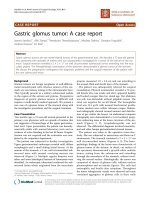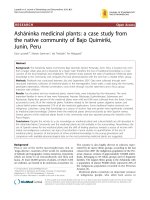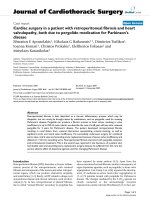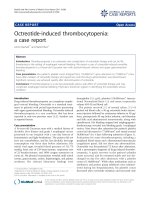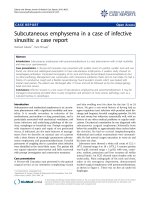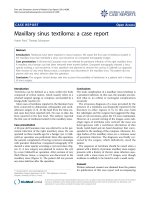Báo cáo y học: " Nitrofurantoin-induced pulmonary fibrosis: a case report" potx
Bạn đang xem bản rút gọn của tài liệu. Xem và tải ngay bản đầy đủ của tài liệu tại đây (793.52 KB, 5 trang )
BioMed Central
Page 1 of 5
(page number not for citation purposes)
Journal of Medical Case Reports
Open Access
Case report
Nitrofurantoin-induced pulmonary fibrosis: a case report
Natascha NT Goemaere
1
, Karin Grijm
2,3
, Peter ThW van Hal
2
and
Michael A den Bakker*
1
Address:
1
Departmentof Pathology, Josephine Nefkens Institute, Erasmus MC – University Medical Center Rotterdam, 3000 CA, Rotterdam, The
Netherlands,
2
Department of Respiratory Medicine, Josephine Nefkens Institute, Erasmus MC – University Medical Center Rotterdam, 3000 CA,
Rotterdam, The Netherlands and
3
Department of Respiratory Medicine, Spaarne Ziekenhuis, 2130 AT Hoofddorp, The Netherlands
Email: Natascha NT Goemaere - ; Karin Grijm - ; Peter ThW van
Hal - ; Michael A den Bakker* -
* Corresponding author
Abstract
Introduction: Nitrofurantoin is a commonly used drug in the treatment and prevention of urinary
tract infections. Many adverse effects of nitrofurantoin have been documented, including aplastic
anemia, polyneuritis, and liver and pulmonary toxicity.
Case presentation: We describe the clinical history and the autopsy findings in a 51-year-old
woman with lung fibrosis of unknown etiology. She had a history of recurrent urinary tract
infections, treated with nitrofurantoin for many years. She was referred to our hospital for
screening for lung transplantation because of severe pulmonary restriction and dyspnea.
Unfortunately, she died as a result of progressive respiratory insufficiency. At autopsy bilateral
patchy, sharply circumscribed fibrotic areas in the upper and lower lobes of the lungs were seen
with honeycombing. Microscopically, end-stage interstitial fibrosis with diffuse alveolar damage was
observed. Due to the atypical distribution of the fibrosis involving both the lower and upper lobes
of the lung, the microscopic pattern of the fibrosis and the history of long-term nitrofurantoin use,
we concluded that this drug induced the lung fibrosis. The recurrent urinary tract infections were
probably caused by a diverticulum of the urinary bladder, which was discovered at autopsy.
Conclusion: This case shows that the use of nitrofurantoin may cause severe pulmonary disease.
Patients with long-term use of nitrofurantoin should be monitored regularly for adverse pulmonary
effects.
Introduction
Drug-induced lung disease is a relatively common condi-
tion. Nitrofurantoin is one of the drugs known to be asso-
ciated with adverse pulmonary reactions. Three types of
reactions have been documented, acute, subacute and
chronic, with various histological reaction patterns
including pulmonary fibrosis. The acute form is more fre-
quently reported in the literature than the chronic form.
Here, we present the clinical history and autopsy findings
of a 51-year-old woman with a history of lung fibrosis of
unknown etiology. The fibrosis was atypical in its distri-
bution and not readily compatible with typical forms of
pulmonary fibrosis, and was finally attributed to the long-
term use of nitrofurantoin.
Published: 21 May 2008
Journal of Medical Case Reports 2008, 2:169 doi:10.1186/1752-1947-2-169
Received: 26 July 2007
Accepted: 21 May 2008
This article is available from: />© 2008 Goemaere et al; licensee BioMed Central Ltd.
This is an Open Access article distributed under the terms of the Creative Commons Attribution License ( />),
which permits unrestricted use, distribution, and reproduction in any medium, provided the original work is properly cited.
Journal of Medical Case Reports 2008, 2:169 />Page 2 of 5
(page number not for citation purposes)
Case presentation
A 51-year-old woman was admitted with progressive
shortness of breath. She had a 1-year history of rapidly
progressive pulmonary restriction of unknown cause. A
high resolution computed tomography (HRCT) scan
revealed bilateral fibrotic changes, with traction bron-
chiectases, focal ground-glass opacities and honeycomb-
ing (Figures 1a and 1b). In addition, her medical history
included polyneuropathy, fibromyalgia, hypercholestero-
lemia and recurrent urinary tract infections. The recurrent
urinary tract infections had been treated with nitrofuran-
toin, prescribed at 15 mg daily for many years, resulting in
a cumulative amount of over 140 g. Urological examina-
tion conducted 4 years prior to the current admission had
not revealed any abnormalities of the bladder. Clinically,
the differential diagnosis of the pulmonary fibrosis
included an adverse reaction to the long-term use of nitro-
furantoin, the result of an undiagnosed collagen-vascular
disease or end-stage usual interstitial pneumonitis (UIP)
(cryptogenic fibrosing alveolitis/idiopathic pulmonary
fibrosis). Although the patient was taking many other
drugs at the time, none of these has previously been
shown to cause pulmonary fibrosis. Autoimmune serol-
ogy, including assays for auto-antibodies against nuclear
antigen, SS-A/SS-B, anti-cyclic citrullinated peptide (anti-
CCP), anti-ds-DNA, Rnase protection (RNP), sphingomy-
elin (SM), antineutrophil cytoplasmic auto-antibodies (c-
ANCA, p-ANCA), anti-Saccharomyces cerevisiae antibod-
ies (ASCA IgA and ASCA IgG), was negative. Further blood
chemistry analysis revealed no abnormalities; in particu-
lar there was no eosinophilia. Because of the severity of
the pulmonary fibrosis, lung transplantation was consid-
ered. The screening examinations, performed 1 month
prior to the current admission and including urological
examinations, revealed no contraindications for trans-
plantation. After the screening procedure the patient was
discharged on glucocorticoids (prednisolone) and azathi-
oprine. She was readmitted with sinusitis, onychomycosis
and elevated liver enzymes [γ-glutamyl transferase (γGT)
363 U/l, aspartate-aminotransferase (ASAT; or glutamate-
oxaloacetate-transaminase (GOT)) 45 U/l, alanine-ami-
notransferase (ALAT, or glutamate-pyruvate-transaminase
(GPT)) 75 U/l and alkaline phosphatase (AP) 90 U/l]. On
admission the chest X-ray (not shown) showed diffuse
bilateral reticular nodular opacities. A liver biopsy showed
mild hepatitis consistent with drug-induced hepatic
injury. She died of respiratory failure after a febrile epi-
sode 16 days after admission. Permission for autopsy was
obtained.
All clinical reports were collected and all previous histol-
ogy was reviewed. A literature search for pulmonary fibro-
sis and nitrofurantoin therapy was performed. The post-
mortem examination was performed according to the
department's standard protocol. Samples from all organs
were selected for histology, and the lungs in particular
were sampled extensively. Routine hematoxylin and eosin
slides were prepared from formalin-fixed, paraffin-
embedded tissue blocks. Special stains for connective tis-
sue (resorcin-fuchsin) and fungi (Grocott) were per-
formed on selected blocks only. At post-mortem
examination adhesions of the pleural membranes were
noted both over the chest wall and diaphragmatic surfaces
of the lung. There was no evidence of active pleuritis and
there was no pleural effusion. Both lungs were firm with
similar gross external appearances and with a similar
aspect of the cut surface. Together the lungs weighed 1060
g. Macroscopically, irregular but sharply defined areas of
residual spongy parenchyma, were surrounded by exten-
sive areas of abnormal parenchyma. Here the lung tissue
was firm and fibrotic with loss of spongy consistency and
with extensive cystic changes, with cysts measuring up to
1 cm in diameter. The abnormal fibrotic parenchyma was
evenly distributed over the upper and lower lobes (Figure
2). Parenthetically, the fibrotic areas were not distinctly
High resolution computed tomography (HR-CT) of the lung showing characteristics of fibrosisFigure 1
High resolution computed tomography (HR-CT) of
the lung showing characteristics of fibrosis. (a) HR-CT
at the level of the main carina. (b) HR-CT at the basal parts
of the lungs 1 cm above the diaphragm. Inter- and intralobu-
lar septal thickening (IST), traction bronchiectasis (TB), hon-
eycombing cysts (HC) and ground glass (GG) are indicated.
Journal of Medical Case Reports 2008, 2:169 />Page 3 of 5
(page number not for citation purposes)
located in sub-pleural or para-septal regions but were scat-
tered throughout the lung lobes. There was no obvious
peribronchial distribution of the inflammation. In the
upper lobe of the right lung a sharply defined 1.5 cm cav-
ity was observed filled with friable yellow tissue (Figure 2,
arrow).
Microscopically, there was a combination of diffuse alve-
olar damage (DAD) superimposed on end-stage intersti-
tial fibrosis (Figure 3). In non-fibrotic lung tissue the
alveolar septae were edematous with sloughing of pneu-
mocytes. Hyaline membranes on denuded alveolar septae
were readily identified. No granulomas were identified.
Small intra-alveolar hemorrhages were present (Figures 3a
and 3b).
The fibrosis appeared temporarily homogenous and
mature, and composed of deeply eosinophilic staining
collagen. Fibroblast foci were not seen. Within the fibrotic
areas of the lungs extensive remodeling of the paren-
chyma was obvious, with cystic dilatation of bronchiolar
structures and transformation of the alveolar architecture
in which the residual alveoli were distended and lined by
bronchial-type epithelium, consistent with honeycomb-
ing (Figures 3d and 3e). Squamous metaplasia was
present in larger bronchioli. Within the cystically dilated
air spaces inspissated secretions were present with an
associated inflammatory histiocytic infiltrate admixed
with neutrophils (Figure 3f). In the fibrotic interstitium
the inflammatory infiltrate was composed of lymphocytes
and histiocytes and patchy in its distribution. Reactive
hypertrophy of bronchiolar smooth muscle was evident
in areas of fibrosis; the inflammatory infiltrate frequently
involved the walls of the bronchioles (Figure 3e). The pul-
monary arteries showed mild to moderate medial hyper-
trophy and intimal thickening in the fibrotic parenchyma.
There was no evidence of vasculitis. Outside the areas with
fibrosis the vascular changes were minor (Figure 3g). The
infiltrate was slightly more dense and diffuse in non-
fibrotic lung tissue with features of diffuse alveolar dam-
age. Eosinophils were not an important feature of the
inflammatory infiltrate. In the right upper lobe an
aspergilloma was seen (Figure 3c). In the pulmonary
arteries fatty streaks were present, consistent with pulmo-
nary hypertension.
The heart showed hypertrophy of both ventricles (right
ventricular wall thickness 9 mm). The liver was congested
and microscopic findings were similar to those seen in the
biopsy. In the urinary bladder a large diverticulum of the
posterior wall was observed with acute and chronic
inflammation.
In summary, the post-mortem findings in this case show
DAD superimposed on end-stage pulmonary fibrosis with
signs of associated pulmonary hypertension and right-
sided heart failure. In addition, an aspergilloma was
present, which developed secondary to immunosuppres-
sive therapy for pulmonary fibrosis. Finally, the DAD may
well have been caused by urosepsis with its focus in the
infected urinary bladder diverticulum. This diverticulum
must have been the cause of the recurrent urinary tract
infections for which long-term nitrofurantoin had been
prescribed.
Conclusion
The pattern of the interstitial disease did not fit with any
of the typical entities. UIP was unlikely considering the
absence of fibroblast foci, the even distribution over both
the upper and lower lobes and the sparing of the para-sep-
tal and sub-pleural regions. Furthermore, the pattern and
histology of the fibrosis did not meet the criteria of other
recognized patterns of pulmonary fibrosis such as non-
specific interstitial pneumonia or desquamative intersti-
tial pneumonia. End-stage extrinsic allergic alveolitis was
considered unlikely considering the absence of granulo-
mas and the non-peribronchiolar distribution of the
changes in the parenchyma. The serological investigations
did not support lung fibrosis in the context of a collagen
vascular disorder. Although histologically 'unclassified',
Transected lung showing randomly distributed areas of fibro-sis with honeycombing and discrete islands of normal spongy lung tissueFigure 2
Transected lung showing randomly distributed areas of fibro-
sis with honeycombing and discrete islands of normal spongy
lung tissue. Arrow: aspergilloma.
Journal of Medical Case Reports 2008, 2:169 />Page 4 of 5
(page number not for citation purposes)
the lung fibrosis seen in this case is considered an adverse
effect of the long-term use of nitrofurantoin.
Diffuse interstitial (restrictive) lung diseases (DILDs) rep-
resent a heterogeneous group. They account for 15% of
the non-infectious diseases seen by pulmonary physi-
cians. Physiologically, DILDs are characterized by reduced
oxygen-diffusing capacity, lung volume and compliance.
In advanced DILD, histology is often non-specific and
shows established fibrosis and honeycombing. The etiol-
ogy of many of these restrictive diseases is not known.
Identified causes of pulmonary fibrosis include environ-
mental elements (asbestos, silica), radiation and drugs.
Nitrofurantoin is one of those drugs; other examples are
busulfan and bleomycin.
Nitrofurantoin is a broad-spectrum antibiotic used for
clinical urinary tract infections, but may also be used in a
prophylactic setting for patients with recurrent urinary
tract infections. It is known to have several adverse effects
such as aplastic anemia, polyneuritis, acute cholestatic
and hepatocellular reactions, and pulmonary toxicity [1].
The acute form of nitrofurantoin toxicity is characterized
by fever, cough and rapid onset of dyspnea [2]. The symp-
toms appear within 3 weeks of initiation of treatment.
Chest X-rays show alveolar infiltrates. Symptoms often
disappear rapidly after discontinuing nitrofurantoin treat-
ment. Bronchoalveolar lavage (BAL) may be useful diag-
nostically, because an increased BAL fluid eosinophil
percentage is found in 40% of the patients with interstitial
lung disease and in 12% of the patients with drug-induced
lung disease [3].
Chronic pulmonary nitrofurantoin toxicity is uncommon
and may develop after 1 month to 6 years of nitrofuran-
toin treatment [1,2]. Chronic nitrofurantoin toxicity is
more commonly seen in older patients and women and
may spontaneously resolve after discontinuing antibiotic
treatment [2].
Drug-induced lung diseases are relatively common and
may result from various complex mechanisms. Different
drugs may produce similar clinical syndromes and one
drug may cause different types of reaction. Nitrofurantoin
is a good example of a drug with many pulmonary mani-
festations including chronic or acute interstitial pneumo-
Hematoxylin and eosin, periodic acid Schiff, Grocott and Elastica von Gieson stained sections of sampled lung tissueFigure 3
Hematoxylin and eosin, periodic acid Schiff, Grocott and Elastica von Gieson stained sections of sampled lung
tissue. (a, b) Diffuse alveolar damage with denuded edematous alveolar septa with thick hyaline membranes and intra-alveolar
hemorrhage. (c) Aspergilloma composed of radiating regularly branched fungal hyphae (periodic acid Schiff stain, insert: high
magnification Grocott stain). (d, e, f) Lung parenchyma with severely distorted architecture consisting of established fibrosis
with sharply angulated and cystically dilated bronchioli with inspissated secretions. In the interstitium a patchy lympho-histio-
cytic infiltrate is present (f). Bronchiolar smooth muscle hypertrophy (e) and squamous metaplasia (f) is seen.
Publish with BioMed Central and every
scientist can read your work free of charge
"BioMed Central will be the most significant development for
disseminating the results of biomedical research in our lifetime."
Sir Paul Nurse, Cancer Research UK
Your research papers will be:
available free of charge to the entire biomedical community
peer reviewed and published immediately upon acceptance
cited in PubMed and archived on PubMed Central
yours — you keep the copyright
Submit your manuscript here:
/>BioMedcentral
Journal of Medical Case Reports 2008, 2:169 />Page 5 of 5
(page number not for citation purposes)
nia, pulmonary hemorrhage, bronchoconstriction,
anaphylaxis and pleural effusion [4]. The lung disease
may be the result of direct toxicity or of indirect inflam-
matory and immunological processes. Direct toxicity in
many cases is dose-related; a typical example of this is
seen in bleomycin therapy. The toxic effect of a drug may
be enhanced by several factors including decreased renal
function and oxygen therapy. The pathological substrate
begins with pulmonary edema, leading to DAD and even-
tually resulting in interstitial fibrosis. Radiographic dif-
fuse lung opacities (reticular or reticulonodular) are seen,
especially in the lung bases. HRCT scans reveal ground
glass attenuation in combination with intralobular lines,
traction bronchiectasis and honeycombing.
Another mechanism for pulmonary drug toxicity is a
hypersensitivity reaction. This reaction is not dose-related
and requires prior sensitization. The pathogenesis is an
interaction between humoral antibodies or sensitized
lymphocytes and the drug. Patients respond to with-
drawal of the drug, but sometimes glucocorticoid therapy
is needed. Other drug-induced pulmonary effects are pul-
monary hemorrhage, bronchiolitis obliterans organizing
pneumonia, lipoid pneumonia and pulmonary granulo-
mas [4].
The most likely cause of pulmonary complications of
nitrofurantoin therapy is a hypersensitivity reaction [5].
The interstitial pneumonitis induced by nitrofurantoin is
now classified as a non-cytotoxic pneumonitis. Non-cyto-
toxic drugs, including nitrofurantoin, can activate lym-
phocytes. Those lymphocytes produce mediators that
cause the release of many cytokines, resulting in a lym-
phocytic alveolitis. Another mechanism described in
patients using nitrofurantoin is the disturbance of the
equilibrium between oxidants and anti-oxidants in the
lung. Nitrofurantoin induces an increased production of
oxidants in the lung, resulting in the activation of several
inflammatory responses [3]. In vitro experiments by Boyd
et al. [6] revealed the production of toxic metabolic prod-
ucts of nitrofurantoin in the presence of oxygen and lung
microsomes. The toxic products may cause lung injury
and thus result in diffuse interstitial lung fibrosis [2]. This
may also explain the prevalence of a chronic pulmonary
reaction in the elderly. Many elderly people have a
decreased creatinine clearance, which may result in accu-
mulation of nitrofurantoin and its metabolites.
In conclusion, nitrofurantoin has its value in the treat-
ment of urinary tract infections, but long-term use may be
complicated by severe toxicity. Patients on long-term use
of nitrofurantoin should be checked regularly for any
complications and in particular for pulmonary fibrosis.
Glucocorticoids may be beneficial in preventing fibrosis
[2,3,5].
Competing interests
The authors declare that they have no competing interests.
List of abbreviations
BAL: bronchoalveolar lavage; DAD: diffuse alveolar dam-
age; DILD: diffuse interstitial lung disease; HRCT: high
resolution computer tomography; UIP: usual interstitial
pneumonia.
Consent
Written informed consent was obtained from the patient
for publication of this case report and accompanying
images. A copy of the written consent is available for
review by the Editor-in-Chief of this journal.
Authors' contributions
PTH and KG were the treating pulmonary physicians and
prepared the manuscript. NG performed the post-mor-
tem, undertook the literature survey and histological anal-
ysis and prepared the manuscript. MAB performed the
post-mortem and histology and prepared the manuscript.
All authors read and approved the final manuscript.
References
1. Israel KS, Brashear RE, Sharma HM, Yum MN, Glover JL: Pulmonary
fibrosis and nitrofurantoin. Am Rev Respir Dis 1973,
108(2):353-356.
2. Hainer BL, White AA: Nitrofurantoin pulmonary toxicity. J Fam
Pract 1981, 13(6):817-823.
3. Boggess KA, Benedetti TJ, Raghu G: Nitrofurantoin-induced pul-
monary toxicity during pregnancy: a report of a case and
review of the literature. Obstet Gynecol Surv 1996, 51(6):367-370.
4. Travis WD, Colby TV, Koss MN, Rosado-de-Christenson ML, Muller
NL, King TE: Non-Neoplastic Disorders of the Lower Respira-
tory Tract. In Atlas of Nontumor Pathology Volume 2. Washington ,
The American Registry of Pathology; 2002:327.
5. Simonian SJ, Kroeker EJ, Boyd DP: Chronic interstitial pneumo-
nitis with fibrosis after long-term therapy with nitrofuran-
toin. Ann Thorac Surg 1977, 24(3):284-288.
6. Boyd MR, Catignani GL, Sasame HA, Mitchell JR, Stiko AW: Acute
pulmonary injury in rats by nitrofurantoin and modification
by vitamin E, dietary fat, and oxygen. Am Rev Respir Dis 1979,
120(1):93-99.
